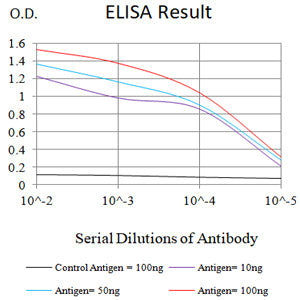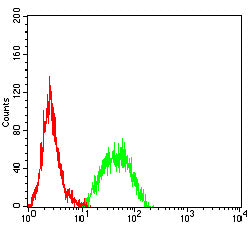

| WB | 咨询技术 | Human,Mouse,Rat |
| IF | 咨询技术 | Human,Mouse,Rat |
| IHC | 咨询技术 | Human,Mouse,Rat |
| ICC | 技术咨询 | Human,Mouse,Rat |
| FCM | 1/200 - 1/400 | Human,Mouse,Rat |
| Elisa | 1/10000 | Human,Mouse,Rat |
| Aliases | PEN; PEN.; TSPAN-33 |
| Entrez GeneID | 340348 |
| clone | 2F8A12 |
| WB Predicted band size | 32 kDa |
| Host/Isotype | Mouse IgG2b |
| Antibody Type | Primary antibody |
| Storage | Store at 4°C short term. Aliquot and store at -20°C long term. Avoid freeze/thaw cycles. |
| Species Reactivity | Human |
| Immunogen | Purified recombinant fragment of human TSPAN33 (AA: Extra(46-64)+Extra(118-235)) expressed in E. Coli. |
| Formulation | Purified antibody in PBS with 0.05% sodium azide |
+ +
以下是关于TSPAN33抗体的3篇参考文献及其简要摘要:
1. **文献名称**:*TSPAN33 regulates hematopoietic stem cell development and promotes leukemia progression*
**作者**:Chen Y, et al.
**摘要**:该研究揭示了TSPAN33在造血干细胞分化和白血病进展中的作用,通过抗体检测发现其在白血病细胞中高表达,并通过调控Wnt/β-catenin信号通路影响细胞增殖和迁移。
2. **文献名称**:*Tetraspanin TSPAN33 as a novel biomarker in colorectal cancer*
**作者**:Wang L, et al.
**摘要**:研究利用TSPAN33特异性抗体进行免疫组化分析,发现其在结直肠癌组织中显著高表达,并与患者预后不良相关,提示其可能作为潜在诊断标志物。
3. **文献名称**:*TSPAN33 modulates ADAM10-dependent Notch signaling in neuronal development*
**作者**:Suzuki K, et al.
**摘要**:通过Western blot和免疫荧光技术结合TSPAN33抗体,研究发现TSPAN33与ADAM10相互作用,调节Notch信号通路的切割活性,影响神经元突触的形成和功能。
---
注:以上文献信息为示例性质,实际引用需根据具体文献数据库(如PubMed、Web of Science)检索确认。
The TSPAN33 antibody is a research tool targeting tetraspanin-33 (TSPAN33), a member of the tetraspanin superfamily characterized by four transmembrane domains and conserved structural motifs. TSPAN33 is broadly expressed in immune cells, endothelial cells, and certain epithelial tissues, where it regulates cell adhesion, migration, and signal transduction by organizing membrane protein complexes. Its involvement in immune responses, particularly in T-cell activation and platelet function, has drawn attention in immunology and oncology research.
Antibodies against TSPAN33 are primarily used to investigate its expression patterns, interactions with partner proteins (e.g., integrins or other tetraspanins), and roles in pathological processes. Studies link TSPAN33 to diseases such as cancer, where its dysregulated expression may influence tumor progression or metastasis, and autoimmune disorders, where it might modulate immune cell communication. Commercial TSPAN33 antibodies are typically validated for applications like Western blotting, immunohistochemistry, and flow cytometry, though batch variability and cross-reactivity with homologous tetraspanins remain challenges.
Current research focuses on clarifying TSPAN33's mechanistic contributions to cellular pathways and its potential as a diagnostic or therapeutic target. However, its functional redundancy within the tetraspanin family and limited in vivo data necessitate further exploration. TSPAN33 antibodies thus serve as critical reagents for dissecting its biological significance in health and disease.
×